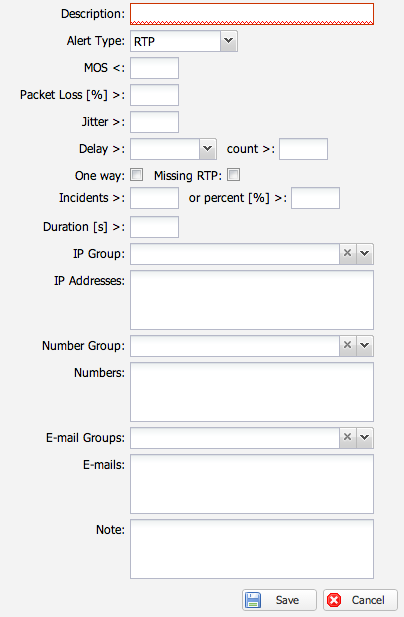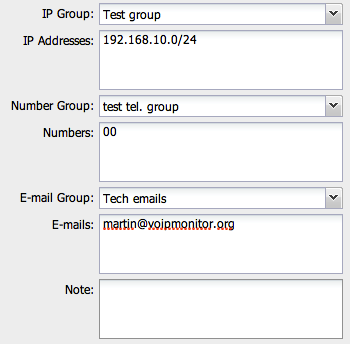Alerts: Difference between revisions
No edit summary |
No edit summary |
||
| Line 1: | Line 1: | ||
Alerts&Reports | == Alerts & Reports == | ||
Alerts & Reports generate email notifications based on QoS parameters or SIP error conditions. It includes daily reports, ad hoc reports, and stores all generated items in history. | |||
Emails use PHP's "mail" function, relying on the server's MTA (e.g., Exim, Postfix, Sendmail). Configure MTA per your Linux distribution documentation. | |||
Process alerts via a PHP script in crontab: | |||
For CentOS & Debian: | |||
echo "* * * * * root php /var/www/html/php/run.php cron" >> /etc/crontab | echo "* * * * * root php /var/www/html/php/run.php cron" >> /etc/crontab | ||
( | (Adjust path to run.php based on VoIPmonitor GUI installation.) | ||
Reload crontab: killall -HUP cron (or crond). | |||
=== Configure Alerts === | |||
Email alerts trigger on SIP protocol or RTP QoS metrics. Types: RTP alerts and SIP signaling. | |||
Common filters: Call duration, IP addresses, numbers, and email recipients. | |||
[[File:alertgrid.png]] | [[File:alertgrid.png]] | ||
Alerts | * '''RTP Alerts''': Trigger on MOS, packet loss, jitter, delay, one-way calls (answered but one RTP stream missing), or missing RTP (answered but both streams missing). Alert if thresholds exceeded and incidents > set value or CDR percent > threshold. | ||
[[File:alertrtpform.png]] | [[File:alertrtpform.png]] | ||
SIP | * '''SIP Response Alerts''': Trigger on SIP response codes. Empty response: All call attempts per filters. Response 0: Unreplied INVITEs. | ||
[[File:alertsipform.png]] | [[File:alertsipform.png]] | ||
* '''Filters''': | |||
- IP/Number Group: Apply to defined groups (from Groups menu). | |||
- IP Addresses/Numbers: Individual IPs, numbers, or ranges (delimited by Enter). | |||
- Email Group: Send to group-defined emails. | |||
- Emails: Individual emails (delimited by Enter). | |||
[[File:alertgroup.png]] | |||
=== Sent Alerts === | |||
Sent alerts are saved in history, matching email content. | |||
[[File:alert-sentalerts.png]] | [[File:alert-sentalerts.png]] | ||
Parameters table shows QoS metrics with bad values highlighted. | |||
[[File:alert-perameters.png]] | [[File:alert-perameters.png]] | ||
CDR records table lists cases, with alert flags: (M)OS, (J)itter, (P)acket loss, (D)elay. | |||
=== AI Summary for RAG === | |||
'''Summary:''' This article covers VoIPmonitor's Alerts & Reports for email notifications on QoS/SIP issues, daily/ad hoc reports, crontab setup, alert configuration (RTP/SIP types, filters), and viewing sent alerts with metrics and CDR details. | |||
'''Keywords:''' alerts, reports, email notifications, QoS metrics, SIP responses, crontab, RTP alerts, SIP alerts, filters, history, MTA configuration | |||
'''Key Questions:''' | |||
* How do I set up email alerts in VoIPmonitor? | |||
* What are the types of alerts (RTP vs. SIP)? | |||
* How do I configure crontab for alert processing? | |||
* What filters can I use for alerts? | |||
* How are sent alerts stored and viewed? | |||
* What do alert flags in CDR mean? | |||
Latest revision as of 14:02, 10 November 2025
Alerts & Reports
Alerts & Reports generate email notifications based on QoS parameters or SIP error conditions. It includes daily reports, ad hoc reports, and stores all generated items in history.
Emails use PHP's "mail" function, relying on the server's MTA (e.g., Exim, Postfix, Sendmail). Configure MTA per your Linux distribution documentation.
Process alerts via a PHP script in crontab:
For CentOS & Debian:
echo "* * * * * root php /var/www/html/php/run.php cron" >> /etc/crontab
(Adjust path to run.php based on VoIPmonitor GUI installation.)
Reload crontab: killall -HUP cron (or crond).
Configure Alerts
Email alerts trigger on SIP protocol or RTP QoS metrics. Types: RTP alerts and SIP signaling.
Common filters: Call duration, IP addresses, numbers, and email recipients.
- RTP Alerts: Trigger on MOS, packet loss, jitter, delay, one-way calls (answered but one RTP stream missing), or missing RTP (answered but both streams missing). Alert if thresholds exceeded and incidents > set value or CDR percent > threshold.
- SIP Response Alerts: Trigger on SIP response codes. Empty response: All call attempts per filters. Response 0: Unreplied INVITEs.
- Filters:
- IP/Number Group: Apply to defined groups (from Groups menu). - IP Addresses/Numbers: Individual IPs, numbers, or ranges (delimited by Enter). - Email Group: Send to group-defined emails. - Emails: Individual emails (delimited by Enter).
Sent Alerts
Sent alerts are saved in history, matching email content.
Parameters table shows QoS metrics with bad values highlighted.
CDR records table lists cases, with alert flags: (M)OS, (J)itter, (P)acket loss, (D)elay.
AI Summary for RAG
Summary: This article covers VoIPmonitor's Alerts & Reports for email notifications on QoS/SIP issues, daily/ad hoc reports, crontab setup, alert configuration (RTP/SIP types, filters), and viewing sent alerts with metrics and CDR details.
Keywords: alerts, reports, email notifications, QoS metrics, SIP responses, crontab, RTP alerts, SIP alerts, filters, history, MTA configuration
Key Questions:
- How do I set up email alerts in VoIPmonitor?
- What are the types of alerts (RTP vs. SIP)?
- How do I configure crontab for alert processing?
- What filters can I use for alerts?
- How are sent alerts stored and viewed?
- What do alert flags in CDR mean?





